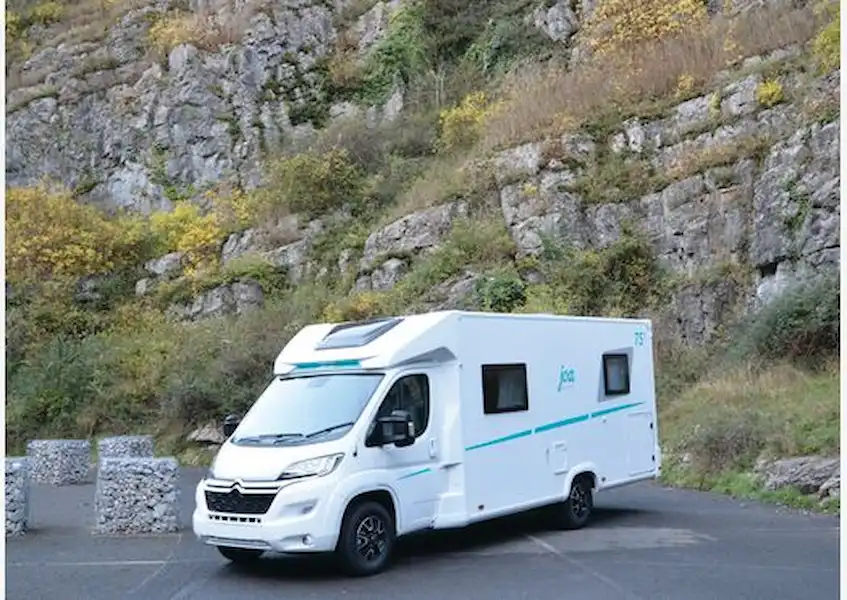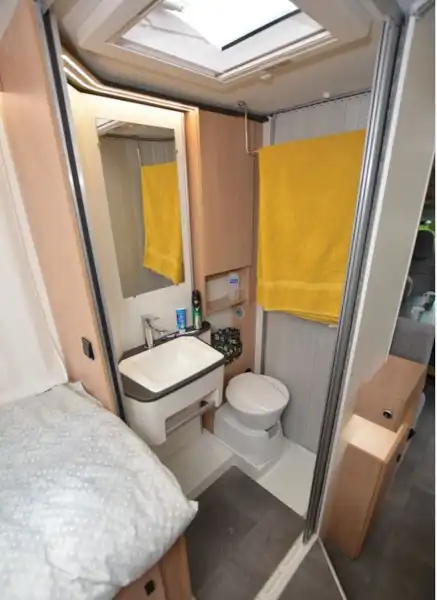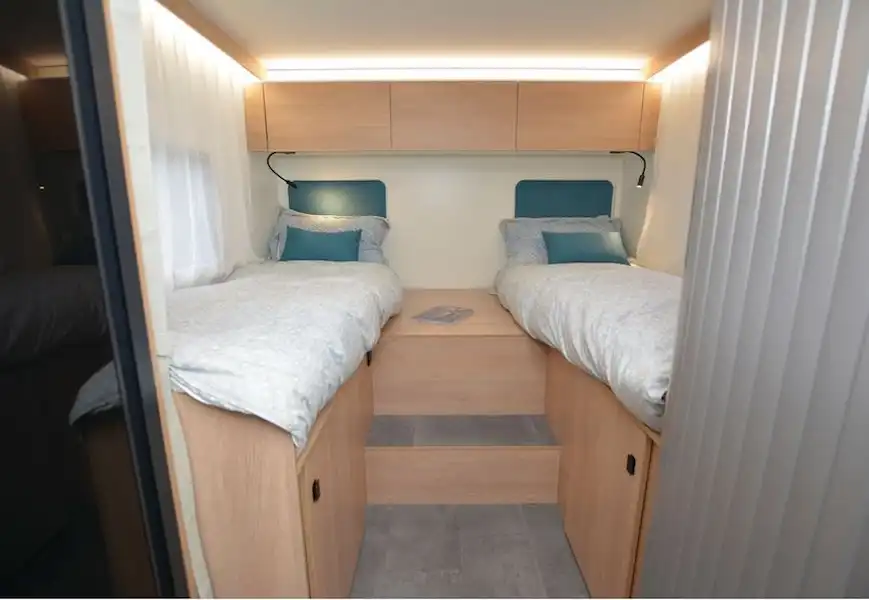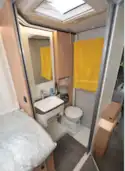Key Features
| Model Year | 2022 |
| Class | Low Profile |
| Base Vehicle | Citroën Relay |
| Price From (£) | 53,900 |
| Engine Size | 2.2TD |
| Maximum Weight (kg) | 3,500 |
| Berths | 2 |
| Main Layout | Fixed Single Bed |
At a glance
Full review
Words and photos: Peter Vaughan
The Joa Camp 75T low-profile motorhome
It’s never a surprise when another European brand pops up on the UK market, but Joa Camp isn’t just new to us, it’s a new brand. Not that it lacks pedigree, as it comes from Groupe Pilote (which started building motorhomes in 1978 and has been selling them here since the mid 80s). Joa Camp vehicles even roll down the same French production lines.
The aim of the new marque is to appeal to first-time buyers, who have made up a large proportion of the market since Covid struck, with a more affordable product range. It offers an easy-to-comprehend line-up of five low-profile motorhomes and three campervans, all based on the Citroën Jumper (usually known as the Relay on these shores) and prices start at under £50k. Don’t expect a
bewildering array of options, either – part of the simplified approach is to provide a basic standard spec and then three options packs, but little else in the way of personalisation. And don’t ask for a brochure – all the marketing is online.
The name means joy in the Breton language that’s local to Pilote’s base near Nantes and was selected as something easy to remember.
The company certainly hopes it’ll be on the tip of your tongue as you peruse rivals such as the Erwin Hymer Group’s Capron companies (Carado and Sunlight), as well as budget brands from Trigano, including Benimar and Roller Team. Here, it will also have to tempt buyers away from homegrown products such as the Auto-Trail Expedition, Elddis Autoquest and Swift Edge.
Options and specification
Already, Joa Camp has a network of eight UK dealers stretching from Scotland down to Devon and including Northern Ireland, too, and the first right-hand drive examples landed at Davan Caravans & Motorhomes near Weston-super-Mare where we collected this 75T model.
The ‘75’ part indicates the overall length (even if it should really be called a 74) – there’s also a 70 version whose layout differs only in having a shorter lounge. Then, the ‘T’ is for twin beds, while you can alternatively have a ‘Q’ version (with queen’s bed, or island bed as we normally refer to them). The ‘T’ and ‘Q’ layouts have the same lounge, washroom and kitchen – just the bedroom changes.
Immediately prior to our test (in late November), Joa Camp had been advertising a super-keen starting price of £47,900 for either of the 75 models but, as price increases rippled through the market, we were told to expect this to rise by £4,000! Other makers are expected to follow suit with similar substantial increases.
As with other entry-level models, there are also options packs that you won’t want to be without. The Chassis Pack adds LED daytime running lights, a leather steering wheel with radio/phone controls and 16in alloy wheels, while the Living Area Pack contributes cab carpet, the Skydome overcab sunroof, a habitation door with window and flyscreen, a towel rack in the washroom and a regulator to allow en route use of the heating. You’ll need to find another £870 for each of the packs.
Arguably not quite so essential is the considerably pricier Extra Pack, costing £3,260. This ups the spec to include a 100W solar panel, a DAB radio with 8in touchscreen, a reversing camera, an extra cushion to convert the lounge into a bed, Combi 6 EH heating (standard being the gas-only 4kW unit), and an insulated waste tank. Add all three packs and you’ll still see change from £60k.
It’s worth noting, though, that even the most basic Joa Camp includes colour-coded bumpers and door handles, driver and passenger airbags, cab air-conditioning, cruise control and tyre pressure monitoring.
On the outside
Externally, Pilote hasn’t just reused mouldings from its existing models. The overcab and the join panel where cab meets coachbuilt are strikingly angular, but the white skirts are still aluminium rather than cheaper plastic. Polyester is used for the roof, side panels and underfloor, too, while Styrofoam insulation completes the uncompromised body spec. Yes, the rear is flat and plain but the bumper in three sections should make for cheaper repairs – reflecting novice motorhomers buying into the brand?
Another change from the usual Pilote fare is the chassis. Although the Citroën Jumper comes out of the same Sevel factory as the Fiat Ducato and Peugeot Boxer, we’re less familiar with the double chevrons on the front of a motorhome. Like the Pug, the Citroën misses out on the Fiat’s new features but you’re not missing much except the ability to opt for an automatic.
Personally, I prefer the Jumper’s classic chrome-ringed dials to the Ducato’s new instrumentation.
On the road, there’s the usual firm ride of a Sevel chassis (eliciting quite a few rattles from the living area) as well as surefooted stability from the Camping-Car chassis with its lower frame and wider rear track.
Performance from the 140bhp motor seemed more than adequate.
All models in the range are designed to be 3.5-tonne motorhomes, again to suit first-time buyers, but it is possible to upgrade to 3,650kg for £390. As the 75T can be spec’d as a five-berth, that might be worth considering for some owners.
The rear locker has an internal height of 950mm and width reduces from 1.04m on the offside to just over half that inside the nearside door, where the gas locker intrudes. However, like Pilotes, the Joa Camp’s capacity for Calor is generous, taking two 13kg cylinders.
The French maker says that its interiors are “strongly inspired by Scandinavian atmospheres”. There’s definitely a light, bright feel inside this 75T, with the bold turquoise graphics of the exterior being reflected by similar contrasting cushions and drapes within. The white walls reflect the light and even the pale woodwork contributes to the impression of space.
As well as the overcab sunroof, the more open-plan segue from kitchen to bedroom with its broad centre aisle helps make this motorhome feel bigger than its entirely typical overall dimensions. There are steps in the floor, though, down from the cab and up into the sleeping quarters and washroom, so headroom varies from 2.10m to 1.88m.
The beds
The drop-down bed here is less intrusive than some and it’s an option (priced at £1,130). You can have any 70 or 75 model with or without it but the longer vehicles have the advantage of maintaining easy access through the door when the bed is lowered (the mattress is shaped to cater for this).
Just one cushion needs to be moved before flicking the switch and bringing down the upper berths. It’s a surprisingly long bed, too, and, with a one-piece mattress on a slatted base (as well as 700mm headroom and twin reading lights), it’s a comfortable space for adults (as long as they’re OK using a ladder). You can leave a duvet on top when stowing it, but not pillows as well.
Underneath, the 75T’s fifth berth is also refreshingly easy to create, although you will probably have to store the large infill cushion in the garage. Just lower the table (manually), pop this extra cushion on top and you have a bed so long that it doesn’t matter that the top lockers from the drop-down bed intrude above.
Then we come to the 75T’s end bedroom and discover the reason for the relatively modest garage below. These beds are just 790mm off the floor, making for much easier access than in most rivals, as well as more headroom above the beds and a greater feeling of space. The beds aren’t especially wide and there’s no option to convert them into a double, but this is an appealing bedroom with a wide surface for drinks, books, etc, between the mattresses, a dash of colour on the headboards, and flexible wand reading lights with built-in USBs (which we’d have liked to see in the cab as well).
Furthermore, the offside bed is a very generous 1.98m long (2.09m if you measure wall-to-wall) and the whole bedroom can be separated off, as an en suite, via a concertina screen. It’s just a pity then that headroom between cupboards and pillows is a bit compromised for sitting up in bed.
Storage
Another aspect resulting from the lower beds is the storage beneath. There are very large cupboards under the foot of each bed, but neither is a wardrobe. The Combi boiler lives below the offside berth but the deeper nearside cupboard could, perhaps, have the addition of a hanging rail – top-to-bottom it’s a maximum height of 840mm in there.
Incidentally, the lounge’s top cupboards are more generous than we’ve come to expect beneath drop-down beds. There’s not a huge amount of under-seat storage, however, and we were disappointed by the loose leisure battery and mass of wiring under the side seat.
The lounge
With berths for a quintet, it’s good to see such a spacious lounge area – the feeling of space is quite a recurring theme in the 75T. The table, too, is super-sized – ideal for family dining but a bit dominant at other times.
The nearside L-settee was my favourite spot for a bit of feet-up chilling, while the side seat opposite is a good size and the cab chairs take the capacity up to at least six folk in here. There’s plenty of lighting, via downlighters in the drop-down bed base and LED strips under the top lockers, but no reading lights, and nothing in the cab.
The front seats are higher than the rest of the lounge but it doesn’t seem to matter as much here as in some other models. And, while the rest of the side windows get pleated blinds, it’s just curtains around the cab.
The kitchen
If the lounge impresses, the galley might seem to have lost out in comparison. It has just two rings on the hob and limited worktop, with no folding panel to extend it. There are, however, three large soft-closing drawers, so storage is not an issue and the oven/grill is an option that’s sure to be fitted in all UK Joa Camps.
The fridge has a generous 139-litre capacity as well as automatic energy selection, so, not for the first time in an entry-level imported motorhome, it’s the cooler that’s the star of the kitchen.
The washroom
It’s one single space for ablutions on the nearside (rather than opposing shower and toilet areas) that helps to make the rear of the 75T feel more open and roomy, but Joa Camp has still managed to incorporate an excellent washroom – by pinching a proven design from its parent.
With the superior Dometic toilet, useful storage, a drying rail, roof vent and even a little worktop, the washroom comes up trumps. Then you release the wall behind the basin, swing it 90 degrees to the right and bolt it to the ceiling and you have a good-sized shower cubicle with twin drains and no horrid clingy curtain. It’s a great bit of design, marred only on this example by a tambour door so stiff that I feared getting trapped in the washroom for the night!
Motorhome supplied by
Davan Caravans and Motorhomes
Tel: 01934 510606
davan.co.uk
Insurance: £436
Tel: 0800 975 1307
shieldtotalinsurance.co.uk
For quote details: motorhome.ma/QuoteInfo
Videos
Expert motorhome advice to your door!
Why not subscribe to one of our fabulous magazines and get expert advice, travel ideas, technical help and all the latest news for your motorhome and your motorhome adventures!
Want to know more about MMM magazine?
Every month MMM has articles written by motorhomers who have been there and done it, from great UK and European (and further afield) tours, campsite reviews, owners' reports and DIY projects among other things. MMM's tests, reviews and expert buying guides are not to be missed. MMM's technical advice is a must and includes everything from weekend jobs to longer-term DIY projects. And much more!
About MMM magazineWant to know more about What Motorhome magazine?
Every issue of What Motorhome magazine provides essential buying advice for anyone looking to buy a new motorhome or campervan or upgrade their existing model. With a pedigree of over 30 years of offering the best motorhome and campervan buying advice, every issue of What Motorhome includes more new motorhome and campervan reviews than you will find in any other magazine.
About What MotorhomeWant to know more about Campervan magazine?
Campervan is the exciting monthly magazine that will give you all the inspiration you need to explore the world in your campervan. Every issue is packed with real-life campervanning experiences, inspiring travel ideas in the UK and further afield, the best campsites to stay on, campervan road tests and reviews of the latest models, and much more!
About Campervan magazine
















